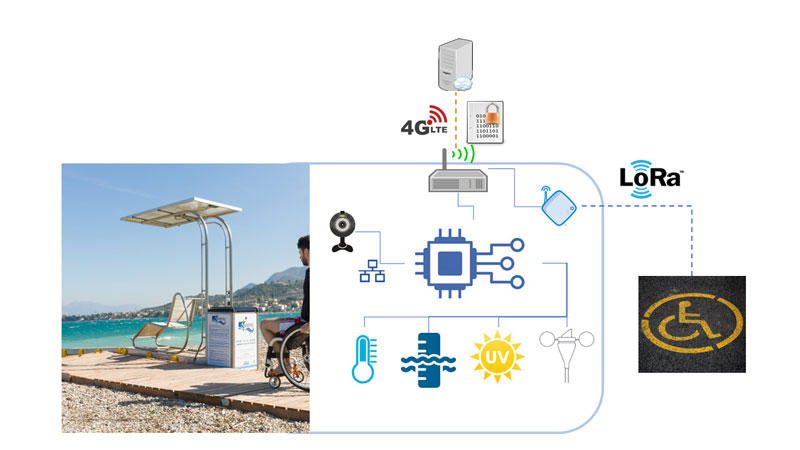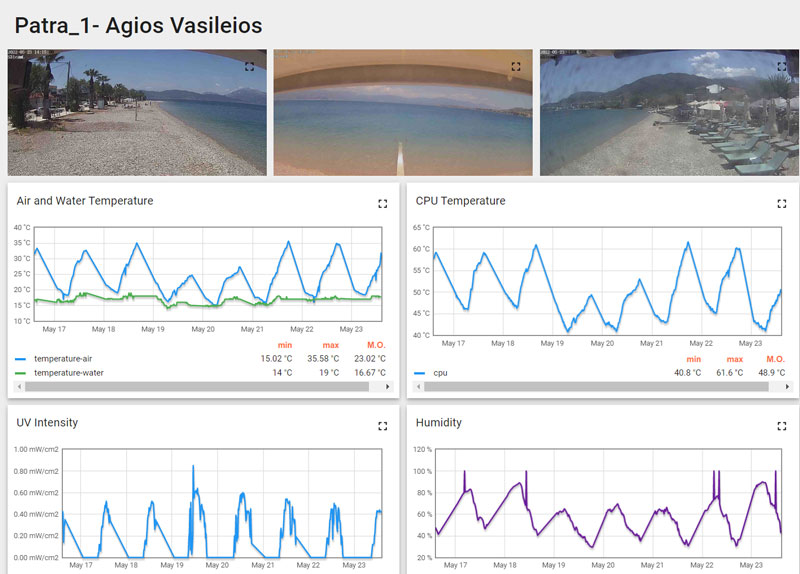by Christos Alexakos (Industrial Systems Institute/ATHENA RC), Ignatios Fotiou (TOBEA) and Panagiotis Konstantinopoulos (Computer Technology Institute and Press "Diophantus")
Modern technology achievements, such as the rail-based infrastructure of SEATRAC© allow people with kinetic disabilities to enjoy access to the sea. In the project SMART SEATRAC, we empowered the existing supporting autonomous access to the sea infrastructure with an embedded data aggregation system, connected with various sensors to collect and transmit information to the end-users, presenting them, in near real-time, the conditions on the beach to assist them in their decision.
Over the past decade, engineering evolution has allowed the development of technological solutions permitting people with kinetic disabilities to have access to the sea easily and without major assistance from third persons. One of these solutions, the SEATRAC© [L1] is a mechanical construction comprising a sheet on a railway and a motor, and it can be used by people with disabilities to safely manoeuvre themselves into and out of the sea. In the project SMART SEATRAC[L2], TOBEA – the company that designs and produces SEATRAC© – in cooperation with Computer Technology Institute and Press "Diophantus" and University of Patras, aimed to enhance the beach installation with smart sensors that collect data from the environment and store them to the cloud. This information will be analysed and properly published for people with disabilities to assist them in their decision to visit a beach that supports their needs. The scope is to minimise unnecessary movements and to give the opportunity to people with kinetic disabilities to enjoy safely swimming at sea.
The next generation of SEATRAC© installations are empowered with a new embedded device that is based on a Raspberry Pi 2 Model B small single-board computer, which acts as the main data aggregation unit (Figure 1). A series of sensors for water temperature, air temperature, humidity, and UV radiation, and an anemometer are connected to a breadboard that contains an analog-to-digital signal converter wired to the digital inputs of the Raspberry Pi board. Further, a set of IP cameras are set in a panoramic position on the top of the installation, and through Ethernet are connected to the aggregation unit. The images from the camera are processed in the aggregation unit by a script that identifies human faces and bodies. The detected human parts are blurred, and the original images are deleted to protect the privacy of the visitors of the beach. In addition, in the cases where there are parking lots especially for people with disabilities, parking lot sensors transmitting through LoRa network can detect if there are free parking spaces. A LoRa gateway is installed in the SEATRAC© installation to receive data from the parking sensors. Both the aggregation unit and LoRa gateway are connected to a 4G Lte router that connects them with the internet for transmitting data to the cloud.

Figure 1: SMART SEATRAC component architecture.
The SMART SEATRAC cloud platform consists of two major systems: the Data Storage and Analysis Platform and the Public Portal. The Data Storage and Analysis Platform is based on the ThingsBoard opensource platform, a platform widely used in IoT systems [1]. The platform gathers data from all the SEATRAC© installations and stores it in a NoSQL database. Further, it provides a set of graphic tools for data analysis as well as real-time monitoring, as depicted in Figure 2.

Figure 2: Real-time monitoring and visual analysis of the aggregated environmental data.
The Public Portal is a web portal tailored to people with disabilities, and it is designed to offer them all the necessary information for their choices to visit the sea. The portal has been designed to be easily used on both PCs and small devices (tablets and smartphones). The visitors to the portal can see in an interactive digital map the beaches where there are installations of SEATRAC©. If they permit their device to locate their position, the portal can focus on the nearest beaches. Further, the portal presents information about the operational status of each installation, i.e., if it is working, or if it is temporarily out of order or under maintenance. Additional information about the supporting facilities is also available, such as the existence of changing rooms, showers, and parking for people with disabilities. In the case of parking, the visitors can see the available parking spaces. Apart from the information regarding the SEATRAC installation, the visitors are informed of the environmental conditions of the beach. They can see the temperature of the water and the air, the humidity, and the wind speed. For the protection from UV radiation, the simplifying scale of the UV index is used, informing the visitors about the danger of staying for a long time in the sun unprotected. The images from the beach also provide useful information to the visitors as the can see in near real-time the condition of the sea, the height of the waves, and how crowded is the beach.

Figure 3: SMART SEATRAC Public Portal interactive map with installations at Greek beaches.
The SMART SEATRAC project focused on taking advantage of an installation near the beach for gathering useful information for people with kinetic disabilities. People can be informed about the operational status of the infrastructure of the SEATRAC at the beach, supporting infrastructure (showers, parking lots, etc.), the environmental conditions, and the number of visitors on the beach. For the evaluation of this approach, the system was deployed and operated for three months during the summer of 2021 at four beaches in Greece. The next steps include the addition of a novel sensor that detects viruses and bacteria in sea waters and evaluation of the public portal from the end-users. This article presents research work that was implemented in the context of the “Smart SEATRAC” project, which was partly funded by the Greek State and the European Union, in the framework of Action “I Research – Create – Innovate” of the Operational Programme COMPETITIVENESS – ENTREPRENEURSHIP – INNOVATION 2014-2020.
Links:
[L1] https://seatrac.gr/en/
[L2] https://smartseatrac.tobea.gr
[L3] https://thingsboard.io/
Reference:
[1] C. Alexakos, et al.: “Building an Industrial IoT Infrastructure with open Source Software for Smart Energy”, in Proc. Conference on Societal Automation 2019 (SA 2019), Krakow, Poland, Sept. 4-7, 2019. DOI: 10.1109/SA47457.2019.8938057
Please contact:
Christos Alexakos, Industrial Systems Institute/ATHENA RC, Greece










